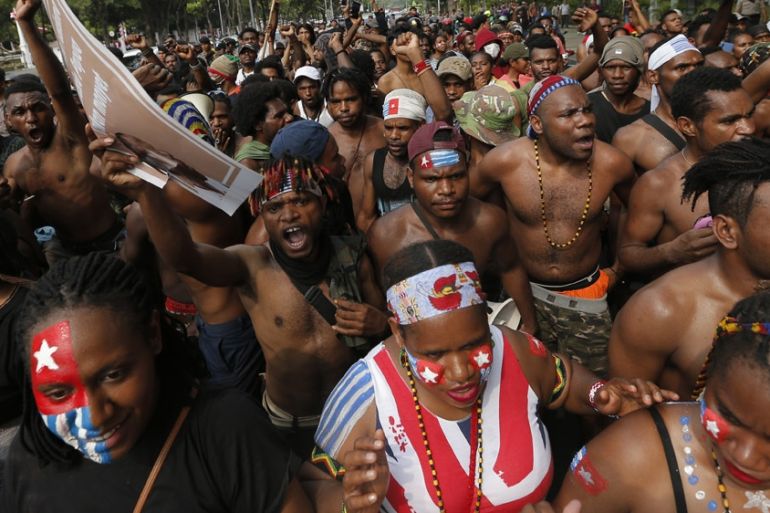One dead, several wounded in Indonesia’s unrest-hit West Papua
A local official in Jayapura confirms death amid warnings that the situation in the easternmost region worsens.

Jakarta, Indonesia – At least one person has been killed as police fired rubber bullets after residents in the West Papuan city of Jayapura in Indonesia attacked Papuan demonstrators, according to an official and a witness.
Rustan Saru, the deputy mayor of Jayapura, confirmed the death to Al Jazeera on Friday, adding that the attack, which also wounded several people, came in response to the protesters destroying public facilities a day earlier.
On Thursday, demonstrators damaged shops and a local government building as they protested against alleged racial discrimination by security forces and bystanders against ethnic Papuan students in Surabaya, on the main island of Java, earlier in August. The two-week demonstrations have since evolved into demands for self-determination and a referendum on independence, in a region where a low-level armed rebellion against the Indonesian government has rumbled for decades.
The residents, most of whom own kiosks and restaurants, were angry at the protesters and blocked some roads to prevent them from marching forward, including a traditional market and the Entrop area, according to Rustan.
He added that the residents in Jayapura were also checking on people passing through, especially Papuan demonstrators who came from the highlands of Meepago, where Deiyai district is located – witnesses on Wednesday said at least six people and one soldier were killed after security officers clashed with demonstrators demanding independence.
A meeting between local elders and police was scheduled to discuss the situation, Rustan said. Since the protests began, authorities have deployed 600 extra paramilitary police from North Borneo to Jayapura.
‘Very extreme, very alarming’
At midday on Thursday, residents in Jayapura’s administrative village of Argapura stopped a car carrying six Papuans from the highlands, a witness who requested anonymity told Al Jazeera.
They dragged the Papuans out of the car, before brutally assaulting and stabbing them with machetes and badek – a traditional knife or dagger. “But the police came and evacuated them to a house,” the witness said.
The residents followed the Papuans after they were evacuated, but police had surrounded the house to ensure their security. As the situation escalated and residents threw rocks, police responded by firing rubber bullets, according to the witness. One of the residents was hit and died when the crowd tried to take him to hospital.
Ahmad Kamal, a spokesman for Jayapura police, told Al Jazeera that he had not yet received any information about the shooting.
Vidhyandika Djati Perkasa, a researcher at the Jakarta-based Centre for Strategic and International Studies (CSIS) described the ongoing civil unrest in West Papua as “very extreme, very alarming”, calling it a red flag for the Indonesian government.
He described it as the worst the region has seen in years and warned the situation was worsening.
“The only way the government can do is to show the courage to solve the main issue – law enforcement – not sending more troops,” he told Al Jazeera.
“If we cannot resolve the civil unrest, there will be a possibility the international community will intervene,” Vidhyandika said.
The government, he added, also needed to assess the effect of the unrest, particularly on the non-Papuans.
|
|
Indonesia’s West Papua region is divided into two provinces: West Papua and Papua. Jayapura is the biggest city in Papua province, home to some 500,000 people.
Overall, there million people live in the ethnically diverse and resource-rich region, where migrants from other parts of Indonesia have more access to the economy than the indigenous West Papuans, resulting in inequality.
The easternmost region was a Dutch colony until the early 1960s when Indonesia made it a part of the country in a controversial 1969 referendum backed by the United Nations.
Since 1964, more migrants have come to the region, with research showing that the percentage of Papuans as a proportion of the population has fallen dramatically under a policy known as transmigration.
Transmigration began under Dutch colonial rule during the early 20th century and was continued by the Indonesian government after independence, with the aim of moving millions of Indonesians from the densely populated inner islands of Java, Bali and Madura to the outer ones to achieve a more balanced demographic development.
Under former leader General Muhammad Soeharto, who ruled for 32 years until 1998, there was a significant increase in transmigration, including to West Papua.
|
|
Veronika Kusumaryati, an anthropologist working on West Papuan issues at Harvard University, described the ongoing unrest as a proof of the complexity of Jayapura’s social culture.
“This is not merely about ethnicity, but the different interests between them [ethnic Papuan and migrants],” she told Al Jazeera.
As Jayapura’s economy has grown quickly, it has attracted more people to the region, Kusumaryati said, with the gap between the indigenous people and the migrants increasing.
“There is no law enforcement, the law only serves those who have access to the economy and politics,” she said, referring to the rich and the elites.
As a result, she said, protesters – who have been blocked from getting political access – expressed their anger, not only by marching but also by destroying the public facilities, shops and other buildings.